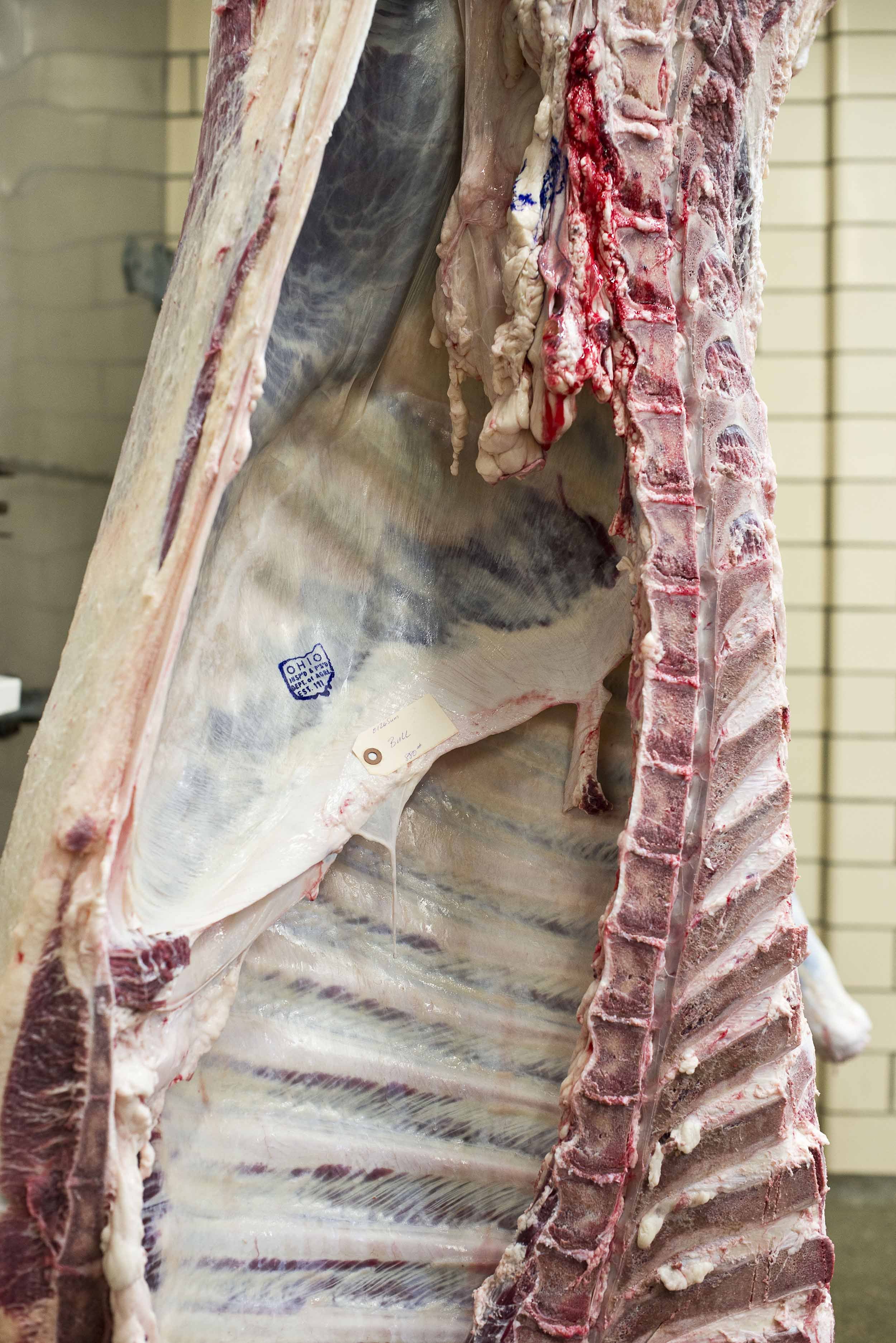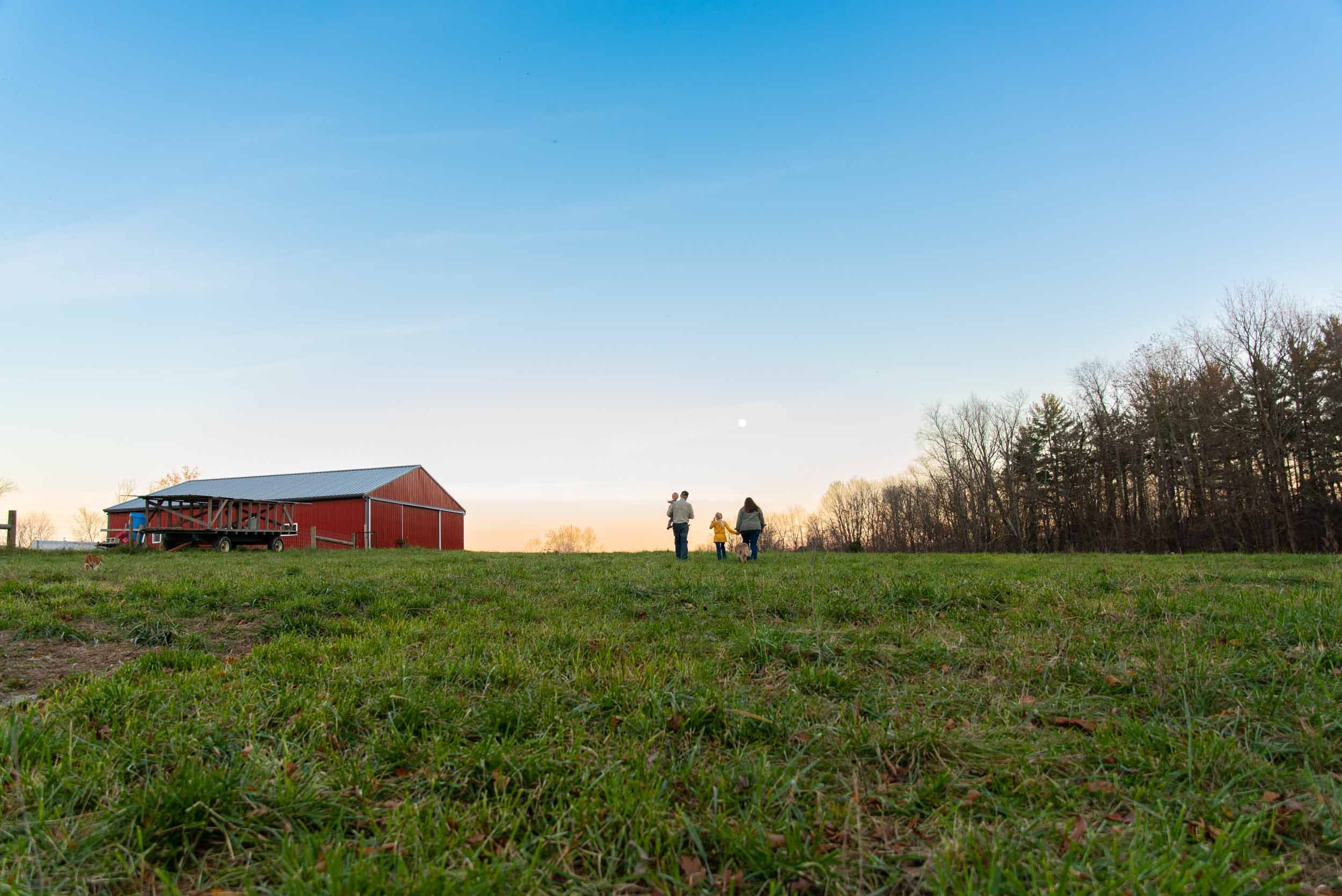Meat-o-nomics (Part I)

Photograph: ©2022, Natalie Jeanne, Grassland Graze in Liberty Township
Smaller-scale, local meat production is an essential and easily overlooked link between our landscape and our food. If there’s going to be a place for small farms in the future, you need to understand these relationships, including your part in this puzzle.
For a brief moment after the pandemic hit in 2020 it looked in parts of the country like we were running out of meat. Tragically, the opposite was true. Processing plant closures and supply chain disruptions left farmers no option but to euthanize millions of animals they were unable to care for or get to market, all while meat cases stood empty in stores. That led some consumers to panic buy and fill their freezers. And it prompted some to consider new options for stocking up, including turning to small local farmers.
“The pandemic exposed vulnerabilities and created extreme disruptions in America’s food supply chain,” said U.S. Department of Agriculture Secretary Tom Vilsack in December 2021 during a visit to a soon-to-be built meat processing plant in Oxford, OH. Vilsack used the occasion to announce $1 billion in federal loan guarantees to back private investment in processing and food supply infrastructure to address what he called “the supply chain bottlenecks that affect small and midsize farmers.”
The plant that Vilsack visited, Stockyards Packing Company, should be a big help to small farmers in Southwest Ohio. According to the company’s website, farmer-owners Andy and Jessica Korb hope to have the plant operational by the end of this year.
“2020 is the first time in most people’s lifetime they went to the grocery store and there wasn’t meat,” says farmer Jess Campbell. “Americans don’t like that feeling whatsoever.” Her business, Carroll Creek Farms in Waynesville, OH, raises grass-fed beef and lamb, and pastured pork and poultry. She saw a big increase in direct sales of whole animals following that shortage.
Smaller-scale, local meat production is an essential and easily overlooked link between our landscape and our food. It’s a food source that often supports sustainable land management, preserves heirloom breeds, and enables an agrarian way of life. This is how it was done before the post-WWII big-farm boom fueled by mechanization and nitrogen fertilizer.
The big meat scare of 2020 underscored the role that small producers play in the supply chain, helping to make it resilient to failure. But it’s hard—crazy hard—to make a living farming small-scale in a marketplace dominated by large-scale industrial production.
The economics of meat production don’t favor those little guys. Add to that a lack of meat packing facilities suitable for small operations and a dearth of skilled labor, and local farmers and ranchers face an ever-uphill battle.
So let’s look at the economics of raising and marketing meat on a small scale. And in the next issue of Edible Ohio Valley, we’ll dive into those supply-chain issues. Because if there’s going to be a place for small farms in the future, you need to understand these relationships, including your part in this puzzle.
THE UPSIDE & DOWNSIDE OF EFFICIENCY
On her 90 acres outside of Waynesville, Campbell is particularly versed in the economics of meat production, both large-scale and small. That’s because her off-farm job—“because it’s basically impossible to farm without one,” she says—is banker. She’s Vice President of Food and Agribusiness with Farm Credit Mid-America, which serves rural communities and the agriculture business. The Mason, OH, native fell in love with farming helping out on her aunt and uncle’s Indiana hog farm. So much so that she started her own farm business from scratch.
When I call her up for a crash course in the economics of meat, she emphasizes the business part, because “a lot of hipsters, no offense, think they can raise a couple of calves or have a garden.” They lack business sense and “very few of them actually know jack about meat science.”
No offense taken. I bring to the conversation assumptions that the tables are tilted in favor of industrial-scale farming, that Small Meat vs. Big Meat is a sort of David and Goliath situation, where David doesn’t have a stone or sling.
Wrong.
“There’s no magic sauce,” Campbell says. “It’s economies of scale in that some of the more artisan enterprises have lower throughput, and by their very nature some of the practices they’re doing are less efficient. So your cost structure is higher.” In other words, the fewer the animals, the higher the cost per animal.
While smaller-scale farming is better for the land, she says, industrial farming is simply more efficient. Far more.
“Let’s just take what I do for a living and layer it over my farm,” Campbell says. On a 14-acre commercial operation, “you could put 10,000 sows that would raise 300,000 weaned pigs a year to be fed and finished. On my 14-acre wood lot I can run approximately 35 to 75 hogs. You tell me which is more efficient from a land use standpoint. That’s the reason we have the food system we do.
“Artisan is an option,” she continues, “but I think forcing that only puts at-risk populations who depend on the cheap food supply at higher risk. How do you view sustainability? Is it land use? Animal welfare? Where is the line drawn? All of these issues are very complex and layer upon each other.”
Why, then, does she farm on a small scale?
“Primarily for people like yourself who don’t really understand how their food is raised,” she says. Growing up in Mason, she had respect for farming at both large and small scale. They’re different worlds.
“Farmers at big scale talk to other big-scale farmers. Artisan farmers talk to other artisan farmers,” Campbell says. “There’s nobody bridging the gap, when frankly they’re not that much different. One is depending on marketing and a high price structure, because they’re not efficient. And the other is working in a commodity market where the lowest-cost producer wins.”
THE MEAT FARMER’S BALANCE SHEET
Let’s consider the farmer’s expenses in raising animals for meat. The biggest is feed, which has gone up drastically since 2020 due to high export demand. With the exception of 100% grass-fed beef, feed is an ongoing expense across the entire lifespan of the animal. Grass-fed cows are in Campbell’s care for about three years, hogs nine months, sheep about a year, chickens for about eight weeks, and turkeys six months.
Meat packing is the second biggest expense. It’s gone up because of supply and demand. And getting animals to the slaughterhouse takes Campbell an almost two-hour drive to Phillips Meat Processing in Zanesville, OH, or Kings Poultry in Versailles, OH. “Locally we were unable to find anybody who could accommodate our size and some of our specifications,” Campbell says.
The biggest limiting factor to Campbell’s business is land, she says. She bought a neighboring parcel of 35 acres in 2019, and will buy more adjacent land if it becomes available.
And land, as the real estate agents say, is hot hot hot.
Our Home Place Meat is a cooperative through which small- to mid-size livestock farmers can market their product. Established by the Berry Center in Henry County, KY, it puts author and advocate Wendell Berry’s agrarian vision into action by supporting sustainable farming. Marketing Manager Beth Douglas says finding affordable land has always been a challenge. But as people increasingly move to the country, escalating prices are putting land beyond reach for small farmers.
“During Covid, people realized that they could do their job remotely,” Douglas says. “And why would you want to pay more to be in a big city when you can just move out, buy a farm, five or 10 acres, and a house? And that’s taking farmland from our farmers.”
Now, let’s look at income from meat sales. Farmers have three primary options for selling their animals. One, they can sell to stockyards and take whatever price they’re offered. Here, prices fluctuate wildly based on the cost of corn. The higher the cost of corn, the less stockyards are willing to pay for animals. Second, they can sell to retail butchers; third, direct to consumers, via an on-farm store like Campbell operates, or at farmers’ markets.
Presented with the option of stockyard sales or managing direct sales, most farmers simply don’t have the time to go the latter route.
Keep in mind that many farmers have that second job. A 2008 USDA study found that more than a third of beef farmers also worked off-farm. “They just want to farm. They want to raise these animals and get paid their money,” Douglas says. “They don’t want to spend their Saturdays at a farmer’s market. I completely respect entrepreneurial farming because that hustle is real. They farm because they want to farm and they love to farm and it’s a part of them. They spend their days working 9-to-5 jobs and then they come home and they feed their animals in the dark.”
A COST-BENEFIT ANALYSIS
The costs are high and sales are challenging. What, then, are the benefits?
Gastroenterologist-turned-grass-fed-cattle farmer Jim Linne bought his 300-acre Highland County, OH, farm in 2005. His path to raising cattle began with a fascination with soil, which bloomed when he enrolled in The Ohio State University Extension Master Gardener program. Linne’s farm was previously used for row crop production. But it’s steeply graded, with slopes susceptible to erosion.
“Since soil was my main goal, I transitioned the entire farm into permanent grassland,” he says. Once you get into grassland, you have to be able to manage it, and that takes livestock. “People don’t think about the role of livestock in improving and maintaining soil,” he says. But if you look back, the richest soils in the country lay where large herbivores—buffalo—roamed.
“So you can repeat that same sort of thing as far as trying to sequester carbon in soil,” he says. “There is nothing that compares to rotationally grazing herbivores.” Since transitioning his White Clover Farm, Linne has seen dramatic improvements to the soil.
Virtually all the producers near him in Highland, Brown, and Adams counties are cow-calf operations, meaning they raise a set of calves every year and sell them at a stockyard to the commercial commodity market.
Linne says that many farmers in his area raise average herds of 40 animals. At most, a farmer can sell an animal to a stockyard for $200 to $300. “That’s the commercial commodity market. And there is no way in the world that on a small scale you can get close to making a living,” he says.
So like Campbell, Linne learned early to direct market, eliminating the middleman and commanding a better price. There’s no other way, as he sees it, “to keep a small farm profitable, keep it in the family, to let it survive.”
THE CONSUMER’S ROLE
Campbell and Linne, along with many other small beef cattle farmers, sell product by the share, meaning a quarter, half, or whole animal. (Campbell also sells individual cuts at her on-farm store.) And that requires effort from the consumer—from us.
In this arrangement, the buyer typically picks the finished meat up from the processor. And you get the whole shebang: both familiar and unfamiliar cuts. “If you don’t eat every cut of beef or you don’t like to have all this variety, if you just want steaks and ground beef, that doesn’t match up,” Campbell says. “Sometimes it’s more affordable to buy a share, especially if you have a larger family.”
Traveling to buy meat, using the whole animal—are those reasonable asks for today’s consumers?
That’s how it was done for most of human history. In recent decades, we have come to rely on suppliers who cater to our ease, who offer shelves and counters replete with variety, with prepared cuts geared toward our busy lives. But is that how things should be?
Going the extra mile to buy a whole animal keeps us from forgetting the farmers who are up before dawn and long after sundown, who cry and sweat over their animals. It keeps the animals, themselves conscious beings, in mind. For those in a position to maintain those connections, that’s not much to ask at all. And in return, the food feeds more than the consumer.
Four multinational companies process 90 percent of the meat in the U.S., Linne says. “So you’re never ever, ever going to beat them on price. We’ve got to work on value, the value of local beef. And I think a lot of that is education.”
Ultimately, supporting small-scale meat farmers comes back to the landscape and health—the environment’s and our own. Linne frames that concept in terms of watersheds. “I think if people understand that the more farmers they can support to farm regeneratively within their watershed, that improves their quality of life. They’re improving the air, the water, the soils. Everything about it.”
So locally and sustainably raised meat might cost more money. But if you’re in the position to, consider eating less, but better quality, meat. When you form relationships with other families, with the farmers and butchers who value better food, could it be that you’re actually getting more—much more—for your buck?
Ever since his grandfather put him to work squashing potato bugs and shoveling compost in a vast organic garden north of Philadelphia, Cedric has loved the outdoors. These days, he squashes bugs for his green-thumbed partner, Jen. His writing has appeared in Saveur, Cincinnati, This Old House, and Belt magazines. He is the Collector at the Mercantile Library Downtown.





